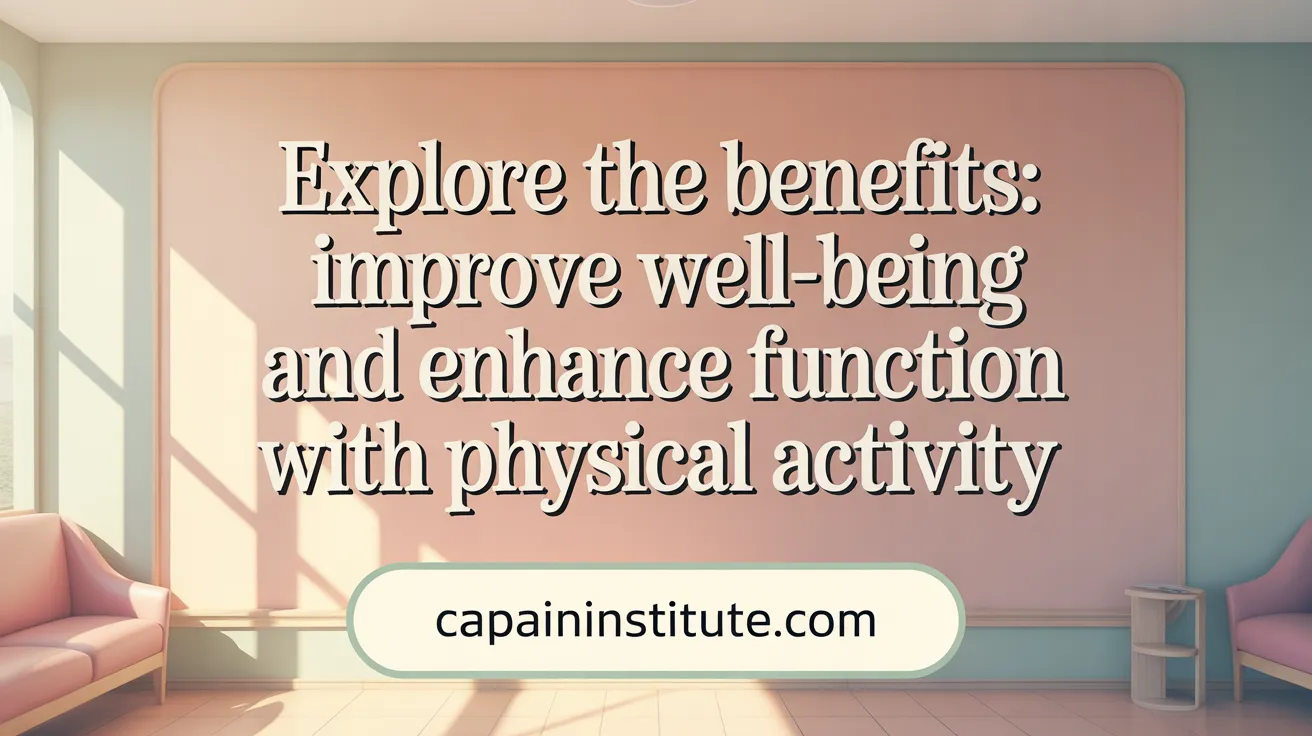Understanding the Promise of Exercise for Chronic Pain
Chronic pain affects millions worldwide, significantly impairing quality of life and daily function. Conventional treatments, often relying on medications or invasive procedures, come with risks and limitations. Increasingly, exercise has emerged as a powerful, safe, and cost-effective tool to alleviate chronic pain symptoms. This article explores the scientific evidence supporting exercise in chronic pain management, examines the mechanisms behind its benefits, outlines recommended exercise types, and provides practical safety guidelines and clinical best practices for integrating physical activity into comprehensive pain care strategies.
<!-- VIDEO:eyJsaW5rIjoiaHR0cHM6Ly93d3cueW91dHViZS5jb20vd2F0Y2g/dj1ib2JIaFdpTk5GVSIsImltYWdlVXJsIjoiZGF0YTppbWFnZS9qcGVnO2Jhc2U2NCwvOWovNEFBUVNrWkpSZ0FCQVFBQUFRQUJBQUQvMndDRUFBa0dCd2dIQmdrSUJ3Z0tDZ2tMRFJZUERRd01EUnNVRlJBV0lCMGlJaUFkSHg4a0tEUXNKQ1l4Sng4ZkxUMHRNVFUzT2pvNkl5cy9SRDg0UXpRNU9qY0JDZ29LRFF3TkdnOFBHamNsSHlVM056YzNOemMzTnpjM056YzNOemMzTnpjM056YzNOemMzTnpjM056YzNOemMzTnpjM056YzNOemMzTnpjM056YzNOLy9BQUJFSUFGTUFsQU1CSWdBQ0VRRURFUUgveEFBY0FBRUFBUVVCQVFBQUFBQUFBQUFBQUFBQUJnRURCQWNJQlFML3hBQkJFQUFCQXdJREFnc0RDZ1FIQUFBQUFBQUJBQUlEQkJFRkVpRVVNUVlIRXpkQlVXRnhjNUd5SXFIUkZTTXlRbE9Ca3JIQjhDUlNjdUVXUTBSaWdwT2kvOFFBR0FFQkFBTUJBQUFBQUFBQUFBQUFBQUFBQUFFQ0F3VC94QUFnRVFFQkFBSUJCQU1CQUFBQUFBQUFBQUFBQVFJUkVnTVRJV0VFTVVGUi85b0FEQU1CQUFJUkF4RUFQd0RScUlpRHFEaUc1dWFUeDV2VVZzS3dXdmVJYm01cFBIbTlSVXFyQmpPMXk3SnM0cHkxcldaajdUU041KzhtMy9IdFVXNlRqTnZZc0VzRjRiM2NJc2o4c2RBSEFYYjlJZzZIVGVPbXkrb0g0NDJhZGtzZE05aGE5OFRyN2pZWlducnVTZGVpM2JwSEpiaDdqMnJCTEJlTkNjZGRMQnREYVJzZDd5OG5lKzdjTDlxc1U0NFNSUnNaSWFPYzZabnUwSjExM1c2T3hPWHBQYjl4SUxCTEJlQ3ovRVRXdkJGRTQ2bHBmZnJGaHBib3VzeWhkaWhxeUsyT25iVDVOREdUbXozL0FDdCt3cDJpNGEvWXNjSWNlandXU2paSkdIN1U4c2FTNndhUmJmNXJHUENPVUMreHRQZElmZ29keDh5T2l3L0IzdGRsdFVQdWIyK3FvZHdkNHc1NktPR2t4R25qcTRta05iSXg5cExYMHZyWSs1Vm5WbU9WbVVPM2NwTEszRTNoQlZ5QXVqdzlybXQxSjVVNmU1ZVhCdzZxSnNVcUtKbUVhUUhLWk9YT3BzQ2RNdWcxdGUrL29YbVlYd3BNODFTSFliTlNzaGpMcEpabkRMYnFhZnJYSFVWYnd2Q2FXbnhaK0p3MTlhWlpIRjduU1BhNXJnZExIVGRhdzdMQlpaL0t3bGtqYkQ0MTFlU1NuaFRNUDlDei90L3NvMXdscUhZM1hRUGZDeUVzanlnWnI5TitwS3pIOE1wNnlXQjhUdzZKeFk0V0pGd2U1V1gxOG5DTEVHUVlQQ1pKR1JaaUhDeHNEcnE0anJDNjh0WEh4SExKWmZOZUppY01PSFBZeXBxWW9jK3JYT0JkZTNVRmNwcWFDcXc1bFpESzF6WGFDdzZqWlJyaHhqcmFTdmRoOVRPK0d1cG5HT1pqR0gyZEFScUxqcE80cjR3SGhsaEVPR01ncTZtU0tScE9ZR0p4QjEwdFlIb3NzWmN0clpZNDhaL1hxMVZPQkxhM1FxcnpxamhiZ0Vqd1cxcEl0OWkvNElyN3FuRnFwRVJGblVIRU56YzBuanplb3FkdWdrYzR1RlhNd0g2b0RMRHphb0p4RGMzTko0ODNxS25GU2FzQm16aU54MXpaaDVkS0RLR2lxdk96NG5iU0tEZjd2TlhtN2FYaS9JTlpiWGZtdmJ5NjBHV2l3MjdkbE9iWnIyMHNIYjBJcnRMYk1OTmI1dDkvaFpCbUlzSS9LQVkwRFozUDF6RTVyZE52MFZMWWdRNjVwcjNHWFIyN3BRYTI0L29tUzRmZ3drSUFFOG5wQzFkUlVrVWNaZXdSZ2dFM0xWMC9DMmR6anRRZ0krcmtCL1ZYdVNqL0FKRytTbkd5Zmc1cmZERFZSTU5WTlpzUkFibW5zSXoxMkhVcHBpV0wwTkJnN2NPWlZRUG1xTHdrQ1VGMGJNcHUvS05UYTN2VzRPU2ova2IrRlU1R0w3Tm40UXNPdDBaMWJMOWFiOUxyZHY3bTNPVXRkQ3lSN3h5cExqY2xsN0g3N3FaY1ZOVzJvNFVTTkhMWDJSNStjL3FiMmxiY0VjWTNNYjVLb1kwRzRhQWV3TG9tV3NaaXd5ODVXdVRlTnZuR3h6eHg2R3FJS1hjYlhPTmpuamowdFVSVlFSRVFFUkVIVUhFTnpjMG5qemVvcllMaVFQWkFKN1RaYSs0aHVibWs4ZWIxRmJBa2JtYmJLMTNZN2Nnc1NUMUFsYzJPQmoyZzJ2eWxqdXZ1VkRVVlFBT3l0N1J5Zy9OWTlWU3ZmSzV4b29wci9SSmxMYkEyditWOUZiRkdSWS9Kc09nNkp1bS9kNzBHV2FpcmFDWFViQUIwOHVMZmttMDFOeWRtWmsxczdsaHI3bGlNcEh0QnRoc0F1TGFUSHkzZGdYMXNmemhCdzZIa3lNdWJsZWk5OTFrR1NhbXF6ZXpTTmNOMXhNTi9WdVExRmFDUDROdHVuNTRmQldIMHJwR3h0a29JUzFwK2p5cDluY09ycVZzVURiT3Zoc043WEE1VTZtL2QxSU14MDlTQzYxSUhBRTJQS2dYUnRSVWtBdXBtaTUxK2RCQTkzZjVMRk5HZEgvSjhaa2M0dWY4QVBFQy9YdTF1cUdsY0I3T0d3bTR1NDhyYlhYczdUNW9NcmFLd05GNk51WW5jSmhhMm11N3Y4bGtRT2tmR0RMSHlidWx0N3JDaGhsZ2RuaW9vV3UzRzB4MUhsKzdxNkpxNnd2U1JkUDhBbmJ2L0FDZ3pFVnFCOHIyWG1qREhYM0EzVjFCeVZ4dGM0Mk9lT1BTMVJGUzdqYTV4c2M4Y2VscWlLQWlJZ0lpSU9vT0libTVwUEhtOVJVNXFaNmlNTk1OTHlsNzV2YnRicTgxQnVJYm01cFBIbTlSVXl4Smp3SThqcW8yekVtR3g4eG9nK25WZFVBKzFFNGtBNWZhK2xyM2RXcSttMWRUWnpuMFpBQklBRHJsMm90N2o3bGhPNWJKcHR3NVVIUU0xYjdYZnA4RlZycFJ5bVVWK1l1Tm5HTzloY0hUeU51OUJsN2RVWEEyQ1h0OW9hS3JhdWN6WkhVVWdibXRuekMzZXJjVkxVeU1qZWEyZHR3RFp6R2cvZm9yZ3BKaE5uMjJVdHpYeVpSYTNVZ2JaVWEvd0V1bis1dXFNckp6STFycUtSb0xzdDh3UDMvdnFWTmpxTTF4WHkyNmkwS2pxR1l1SjI2YTFyV3NFSDF0ZFRhK3hQSTZnOFg2UDcrU3E2c25CT1dpbGNBU0FRUUwyUGFxTXBKZ0dYcTViczB2cDdRMDMrWHZWUlNUQXZ0V1RXZHVGZ2NwdmUvNklMdFBOSktYQ1NCMFFBRnJtOTkvNys5WDFoYkpQcmV0bCs1b1J0Sk9BNE9yWmpjaXh5dDAzOW5kNUlNMUZnaWluQmNUWFRPdUxXc0IwM1dWQXh6SW10a2VYdUc5eDZVSEozRzF6alk1NDQ5TFZFVkx1TnJuR3h6eHg2V3FJb0NJaUFpSWc2ZzRodWJtazhlYjFGYkRXdk9JYm01cFBIbTlSV3cwQkVSQVJFUUVSRUJFUkFSRmpWTlpCVFN4eHl2cytXK1FCcE43YjkzZVBOQmtvc1Q1UnB2dEQxL1FkOEVPSVUxN0dRMy9vZDhFSEt2RzF6alk1NDQ5TFZFVkx1TnJYakd4enh4NkdxSW9DSWlBaUlnNmU0aDJnOFhWR1R2RTgxdnhMWXFJZ0lpSUNJaUFpSWdJaUlDc1RVOE0wakh5d3h2Y3krUXVhQ1czMzJWVVFpamFhRDdDTDhBVnhyR3h0eXh0YTBkVFJaRVFjbThiWE9Oam5qajB0VVJSRUJFUkIvOWs9IiwidGl0bGUiOiJFeGVyY2lzZSBpcyBNZWRpY2luZTogTWFuYWdpbmcgY2hyb25pYyBwYWluIHwgT2hpbyBTdGF0ZSAuLi4iLCJzbmlwcGV0IjoiSm9pbiBQaHlzaWNhbCBUaGVyYXBpc3QgU2VhbiBNZWVycyBmb3IgYW4gaW4tZGVwdGggbG9vayBhdCBjaHJvbmljIHBhaW4sIG1hbmFnZW1lbnQgLi4uIEV4ZXJjaXNlIGlzIE1lZGljaW5lOiBNYW5hZ2luZyBjaHJvbmljIHBhaW4gfCBPaGlvIFN0YXRlIC4uLiJ9 -->Scientific Evidence Supporting Exercise as a Treatment for Chronic Pain

What scientific evidence supports exercise as a method for managing chronic pain?
A substantial body of scientific research, derived from numerous systematic reviews and clinical trials, confirms that exercise is an effective approach for controlling chronic pain. Studies encompassing more than 37,000 patients with various conditions such as osteoarthritis, fibromyalgia, and low back pain provide consistent evidence. These trials show that engaging in regular physical activity can lead to small to moderate decreases in pain intensity and significant improvements in physical functioning.
Most reported adverse effects from exercise are minor, including muscle soreness or increased fatigue, which tend to diminish over time without serious harm. The biological mechanisms behind exercise’s analgesic effects involve complex nervous system pathways. Exercise promotes the release of natural painkillers like endorphins, serotonin, and endocannabinoids, which help inhibit pain signals and modulate pain perception.
Beyond pain relief, regular physical activity enhances mood, sleep quality, and overall well-being. It also serves a protective role by preventing the worsening of chronic conditions through improved muscle strength and joint flexibility. Different exercise modalities, such as aerobic activities, resistance training, yoga, Tai Chi, and Pilates, have been studied, and personalized, gradual programs tailored to individual needs are recommended.
While the evidence supports exercise as a crucial element in pain management, ongoing research underscores the importance of longer-term, large-scale studies to better understand its full potential. Although current data confirms its safety and benefits, the quality of existing evidence varies, emphasizing the need for continued high-quality research.
Overall, exercise establishes itself as a safe, cost-effective, and empowering therapy, capable of reducing pain and improving quality of life for people coping with persistent pain conditions.
How Exercise Alleviates Chronic Pain: Brain Function and Pain Perception

How does exercise alleviate chronic pain and affect brain function and pain perception?
Exercise plays a significant role in reducing chronic pain by inducing changes in brain regions responsible for pain regulation. Neuroplasticity, the brain’s ability to reorganize itself, allows exercise to enhance connectivity in areas such as the cortico-limbic system, default mode network, and dorsolateral prefrontal cortex. These modifications help normalize pain signals, leading to a decrease in perceived pain.
Furthermore, exercise activates central inhibitory pathways. These involve the release of endogenous opioids, serotonin, and cannabinoids—natural chemicals in the body that inhibit pain signals. By engaging these pathways, exercise reduces nociceptive signaling and neuroinflammation, which are often heightened in chronic pain conditions.
In addition, physical activity influences immune responses within the central nervous system. It can shift glial and immune cell activity toward anti-inflammatory states, lowering levels of pro-inflammatory cytokines and reducing microglial activation. Since inflammation in the nervous system contributes to pain amplification, this immune modulation is vital for pain relief.
Exercise also stimulates the brain’s reward circuits, particularly the mesolimbic dopaminergic pathways. This engagement boosts mood, decreases pain-related fear, and alleviates emotional distress associated with chronic pain. Such psychological benefits not only improve quality of life but also reinforce continued physical activity.
Overall, consistent exercise enhances brain function, modulates pain pathways, and fosters psychological resilience. These combined effects contribute to a meaningful reduction in chronic pain, improved mobility, and better mental health.
| Mechanism | Description | Outcomes |
|---|---|---|
| Neuroplasticity | Changes in brain connectivity in pain regulation centers | Reduced pain perception |
| Endogenous analgesia | Activation of opioid, serotonin, and cannabinoid pathways | Diminished pain signals |
| Immune modulation | Anti-inflammatory effects on glial cells and cytokines | Lowered neuroinflammation and sensitization |
| Reward circuit engagement | Activation of mesolimbic pathways to improve mood and reduce fear | Psychological resilience and mood improvement |
This evidence supports the use of tailored exercise programs as a safe and cost-effective option for managing chronic pain, emphasizing the importance of neurobiological changes that underpin therapeutic benefits.
Benefits of Physical Activity: Symptom Reduction and Function Improvement

What are the benefits of physical activity in reducing symptoms and improving overall function in chronic pain conditions?
Physical activity plays a vital role in managing chronic pain by offering a range of health benefits. Regular exercise can significantly reduce pain severity and help control inflammation, which is often a primary factor in ongoing pain. It also enhances muscle strength, flexibility, and circulation, leading to better support of affected joints and tissues.
Engaging in physical activity reduces fatigue, a common symptom in many pain conditions, and helps alleviate psychological distress such as depression and anxiety. These mental health improvements are partly due to the release of endorphins—natural painkillers—that improve mood and overall mental well-being.
Furthermore, exercise positively impacts sleep quality, allowing individuals with chronic pain to rest better, which in turn can lessen pain perception. Importantly, physical activity can help break the cycle where pain discourages movement, which then leads to muscle weakness and increased pain.
When tailored appropriately, consistent movement can lead to improved daily functioning and longer-term quality of life. It fosters resilience by promoting a biopsychosocial approach that addresses physical, emotional, and social aspects of pain. Overall, incorporating suitable physical activity into pain management strategies results in meaningful symptom relief and enhanced physical and mental health.
Recommended Exercise Types for Managing Chronic Pain

What types of exercise are recommended for managing chronic pain?
A variety of exercise modalities are advised to help manage chronic pain effectively. Low-impact aerobic activities, such as walking, swimming, and cycling, are particularly beneficial. These exercises promote cardiovascular health and limb pain relief without putting excessive stress on the joints. They are suitable for most individuals, including those with arthritis or back pain.
Strength training is another essential component. Resistance exercises using weights, resistance bands, or even household items help build muscle strength around painful joints. This reinforcement decreases strain and improves stability, which can reduce ongoing discomfort.
Flexibility and stretching routines also play a vital role. Dynamic stretching before activity prepares muscles and joints, while static stretching afterward helps relax muscles and improve range of motion. Regular flexibility exercises ease muscle tension and stiffness.
Furthermore, activities that improve balance and core strength, such as yoga, tai chi, Pilates, and specific core exercises, are highly recommended. These practices enhance posture, prevent falls, and support the back and neck, alleviating pain and preventing injury.
Importantly, exercise programs should be individualized based on each person’s capabilities and limitations. Tailoring routines ensures safety, maximizes benefits, and encourages adherence.
Overall, engaging regularly in these varied exercise types can significantly reduce pain severity, improve physical function, and boost overall well-being, with minimal risk of adverse effects when properly customized.
Safety Considerations and Guidelines for Exercising with Chronic Pain
What safety considerations and guidelines should be followed when exercising with chronic pain?
Engaging in physical activity offers significant benefits for managing chronic pain, but safety must be a priority. Starting slowly and progressing gradually is essential to prevent exacerbating symptoms. Patients should begin with low-impact activities such as walking, swimming, or tai chi, which are gentle on the joints and muscles.
Modifying exercises based on individual comfort and response helps avoid severe pain or injury. For example, if certain movements cause discomfort, alternative positions or less intense options should be chosen. Incorporating stretching and strengthening exercises tailored to specific needs can improve flexibility and support affected areas.
Consulting healthcare professionals—like physiotherapists or physicians—before initiating an exercise program is highly recommended. These experts can develop personalized plans that align with medical conditions, ensuring safety and maximizing benefits.
Monitoring symptoms during activity is vital. Participants should pay attention to signs such as dizziness, chest pain, or increased pain levels. If symptoms worsen or become unmanageable, stopping exercise and consulting a healthcare provider is necessary.
Focusing on low-impact activities not only reduces the risk of injury but also supports sustained engagement. Education on proper techniques and pacing further promotes safe exercise practices.
By adhering to these safety guidelines—starting slowly, modifying activities, seeking professional advice, and listening to one's body—individuals with chronic pain can safely incorporate exercise into their routines, leading to better pain management and overall quality of life.
Clinical Guidelines and Best Practices for Exercise in Pain Management
What clinical guidelines and best practices exist for incorporating exercise into chronic pain management strategies?
Current clinical guidelines strongly support the integration of exercise into comprehensive chronic pain treatment plans. These guidelines recommend developing individualized, multimodal programs that include various forms of physical activity such as aerobic, resistance, flexibility, and balance exercises. Personalization is crucial, involving assessment of each patient’s specific limitations, goals, and preferences.
Exercise programs should be gradual, starting at low to moderate intensity—typically around 50-60% of maximum heart rate—and increasing carefully over time. This approach helps avoid exacerbating pain or causing injury, while promoting adherence and sustained benefits.
Patient education plays a vital role. Patients should be informed about the objectives of their exercise plan, the importance of consistency, and the need to listen to their bodies. Incorporating mind-body therapies like yoga, Tai Chi, and Qigong is supported as they are generally well-tolerated, improve not only physical function but also mental well-being, and can be tailored to individual needs.
An interdisciplinary approach is highly recommended, integrating physical activity with psychological support such as cognitive-behavioral therapy. This biopsychosocial model acknowledges the complex nature of chronic pain and enhances treatment effectiveness.
Shared decision-making between clinicians and patients is emphasized to boost motivation and adherence, which are essential for meaningful, long-term outcomes.
While evidence supports the safety and efficacy of exercise, further research is needed to establish standardized protocols, optimal intensity levels, and long-term benefits. Nevertheless, current best practices align with encouraging safe, enjoyable, and sustainable physical activity tailored to each individual’s circumstances.
Integrating Exercise into a Comprehensive Chronic Pain Strategy
Multimodal Approaches Combining Exercise with Education and Psychosocial Support
Integrating exercise into a broader treatment plan enhances its effectiveness for managing chronic pain. Combining physical activity with patient education about pain neuroscience and psychological support addresses the complex biopsychosocial factors influencing pain. Such multimodal approaches have been shown to improve not just physical symptoms but also mental well-being, making pain management more sustainable.
Managing Exercise-Related Complications and Preventing Overexertion
While exercise is generally safe, some individuals may experience increased soreness or muscle pain initially. Proper management involves gradual progression, appropriate intensity, and attentive monitoring. Healthcare professionals should guide patients to avoid overexertion, which could exacerbate symptoms, ensuring that exercises are tailored to individual capacity and needs.
Empowering Patients for Adherence and Lifestyle Change
Patient empowerment is vital for long-term success. Strategies include setting realistic goals, providing education on the benefits of continuous activity, and encouraging enjoyment of chosen exercises such as walking, swimming, or yoga. Fostering a positive attitude towards movement helps patients incorporate physical activity as a regular part of their lifestyle, leading to better pain control and improved quality of life.
Exercise as an Effective, Low-Cost Alternative to Pharmacological or Invasive Therapies
Exercise offers a safe, inexpensive alternative or complement to medications and invasive procedures. It reduces dependence on pharmacological treatments that may have adverse effects and is accessible across various healthcare settings. Its cost-effectiveness combined with its ability to improve pain, physical function, and emotional well-being makes it a cornerstone of conservative chronic pain management.
Long-Term Benefits Including Improved Sleep, Function, Mood, and Inflammation Control
Regular physical activity has broad benefits beyond pain reduction. It promotes better sleep quality, enhances daily functional abilities, lifts mood, and helps regulate inflammation — a common driver of chronic pain. Sustained exercise routines contribute to overall health and resilience, creating a virtuous cycle that maintains pain relief and improves life quality over time.
Harnessing Movement to Transform Chronic Pain Care
Exercise offers a multi-dimensional solution for managing chronic pain, combining physical, psychological, and neurological benefits. Supported by growing scientific evidence and clinical guidelines, tailored and supervised exercise programs—emphasizing gradual progression, patient education, and individualized modalities—effectively decrease pain severity, improve function, and enhance quality of life. Importantly, exercise serves as a safe, economically feasible alternative to medications, with minimal adverse effects, and engages central mechanisms that recalibrate pain perception. As research continues to evolve, integrating movement therapy within multidisciplinary pain management remains a vital strategy, empowering patients to regain control and restore well-being through consistent, enjoyable physical activity.
References
- Physical activity and exercise for chronic pain in adults
- Exercise for chronic pain: How physical activity can help ...
- Exercise and Activity in Pain Management
- The Role of Physical Exercise in Chronic Musculoskeletal ...
- Exercise and Chronic Pain
- Exercise for Chronic Pain Management
- Exercise training augments brain function and reduces ...
- Finding Relief Through Movement Chronic Pain and Exercise
- Chronic Pain and Exercise
